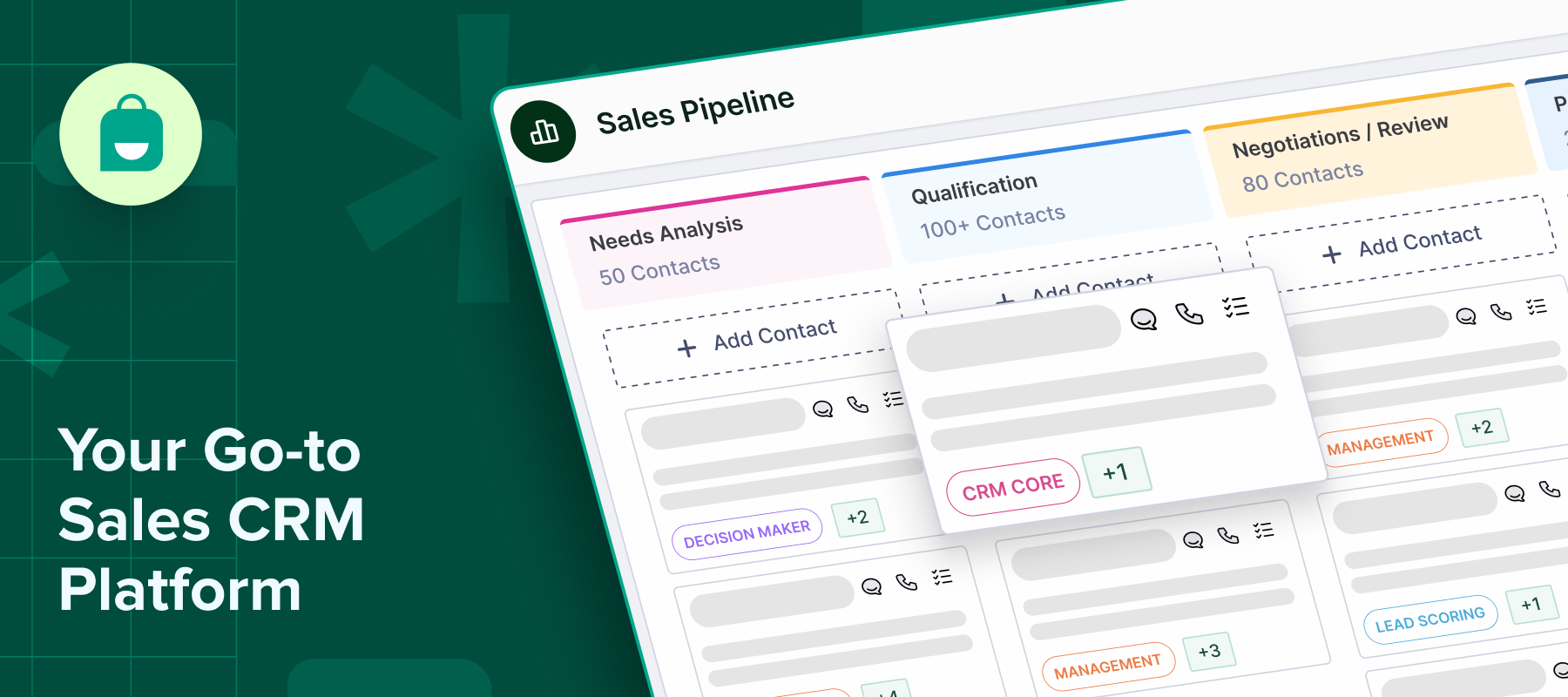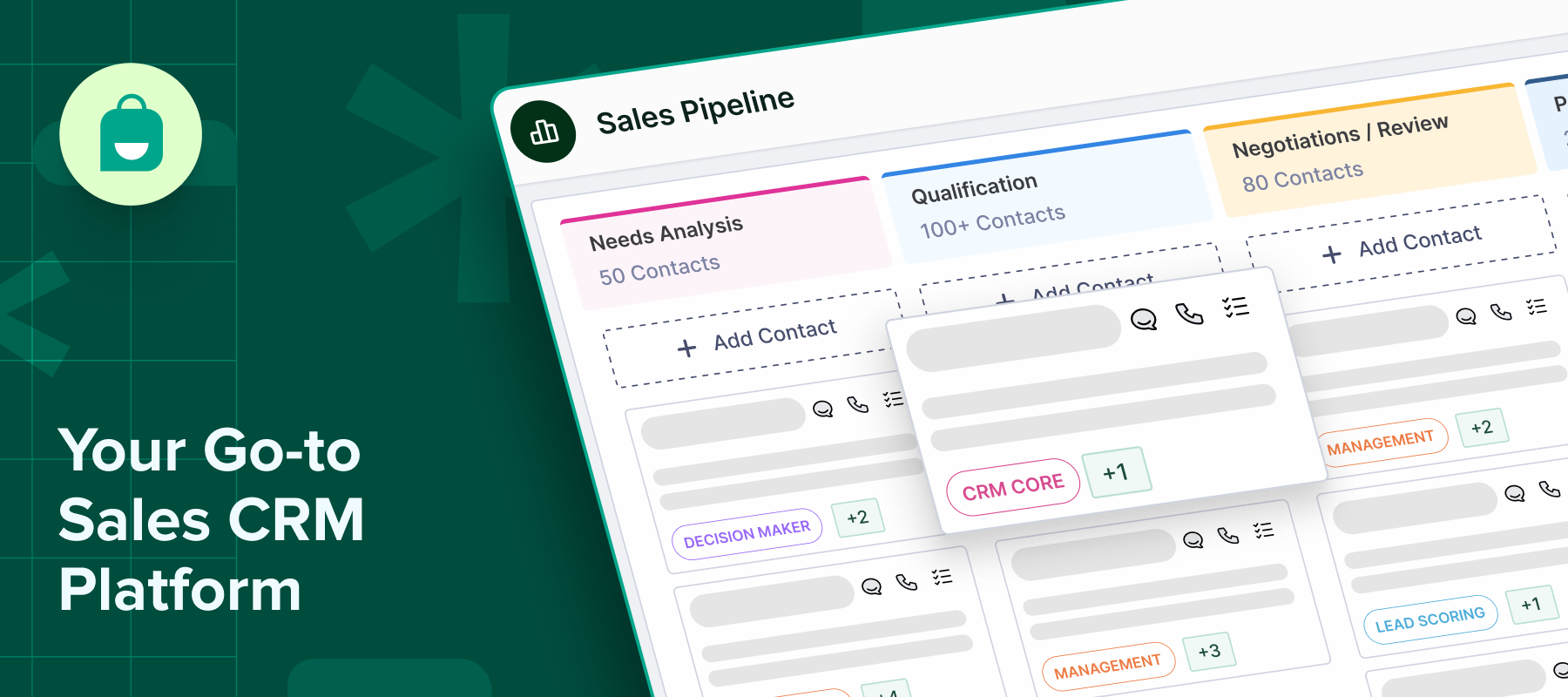Every great customer experience begins when two key engines work in sync, and those engines are the CRM and the marketing platform.
The CRM keeps customer data organized and accessible, while the marketing platform turns that data into action through campaigns, automation, and outreach. When these systems don’t communicate and operate in silos, you end up with scattered data, wasted effort, and missed opportunities.
However, integration changes everything by aligning sales and marketing, creating a seamless flow of information, and delivering a stronger overall impact.
That’s why in this blog, we will share how you can integrate your Sales CRM tools with your marketing platform.
Benefits of CRM and Marketing Platform Integration
Here are some benefits of integrating CRM and marketing platform:
1. Improved customer segmentation and targeting
When CRM and marketing platforms are integrated, businesses can segment customers using accurate data such as purchase history, behavior, and demographics. This improves targeting, increases the relevance of campaigns, and raises conversion rates.
2. Enhanced customer experience and engagement
Integration enables consistent and personalized communication across all channels. Customers receive timely and relevant messages, improving satisfaction, engagement, and retention.
3. Streamlined data management and workflow efficiency
Integrated systems eliminate duplicate records and reduce manual updates. This improves data accuracy, saves time, and ensures sales and marketing teams work with the same information.
4. Better performance tracking and analytics
With combined reporting, businesses can track customer interactions, campaign effectiveness, and sales outcomes in one place. This supports better analysis, faster adjustments, and more informed decision-making.
Step-by-Step Guide to Integrating CRM with Marketing Platforms
Integrating your CRM with marketing tools requires a structured approach. Here’s a practical step-by-step guide to help you plan, connect, and optimize the process effectively:
Choosing the right CRM and marketing platforms for integration
The first key step is selecting a CRM and marketing platform that meets your business needs and supports seamless integration. Your choice will directly impact how well your systems connect and how efficiently your teams work.
A strong option to consider at this stage is Interakt, a WhatsApp Sales CRM designed to help businesses integrate and streamline sales and marketing operations. It offers a range of features that support effective integration:
-Automated lead capture from WhatsApp, Instagram, and APIs
-Personalized WhatsApp workflows for faster lead engagement
-Unified customer view to track all interactions in one place
-Built-in payment reminders to speed up deal closures
-Visual sales pipeline and task management to keep teams aligned
-AI-powered insights for smarter targeting and follow-ups
-60+ plug-and-play integrations
Preparing your systems for integration
Start by cleaning and organizing your data. Update customer records, remove duplicates, and standardize fields. Review the API documentation of both platforms to understand how they connect and whether custom work is needed.
With Interakt’s pre-built integrations, this process becomes faster and simpler, helping reduce setup time and technical complexity.
Connecting your CRM with popular marketing tools
Once prepared, link your CRM to tools like email platforms, social media managers, and automation software. This ensures customer data syncs smoothly, campaigns trigger accurately, and engagement is tracked across channels.
Ensure the tools you select are fully compatible and support real-time data exchange.
Testing and optimizing the integration
Test core workflows, lead capture, email triggers, and customer updates to confirm data is syncing and automation works as intended.
Watch for errors or delays and fine-tune as needed. After going live, monitor system performance regularly and gather user feedback to improve integration outcomes.
Common Challenges in CRM and Marketing Integration
Here are some common challenges in CRM and marketing integration:
-Data consistency issues: Inconsistent or outdated data across systems can lead to errors in segmentation, reporting, and customer communication. It’s essential to clean and standardize data before integration and set up regular syncs to maintain accuracy.
-Compatibility between platforms: Not all CRMs and marketing tools are built to work together. Compatibility gaps can cause delays or require custom development. Choosing platforms with built-in integrations or open APIs, like Interakt, helps avoid these issues.
–Cost of integration: Integration projects can involve software, development, and training costs. It’s important to assess upfront expenses and long-term value to ensure the investment aligns with business goals.
–Resistance to change within the team: Teams may resist new systems or workflows, slowing adoption. Clear communication, hands-on training, and highlighting the benefits of integration are key to gaining team buy-in and ensuring smooth implementation.
Best CRM Tools and Marketing Platforms for Seamless Integration
Here are some of the best CRM tools to consider:
1. Interakt CRM
Interakt CRM is a WhatsApp-first sales CRM designed to help businesses automate sales, nurture leads, and close deals faster on WhatsApp and Instagram. With a setup time of under 30 minutes and over 50,000 businesses onboard, it’s ideal for teams focused on conversational sales, faster response times, and seamless customer engagement.
Top Integrations:
-Shopify
-WooCommerce
-InstaMojo
-Razorpay
-PayU
-WhatsApp Pay
-Stripe
-Facebook Leads Form
-TallyPrime
-HubSpot
-Freshworks CRM
-Zapier
Pricing:
-₹2,499/month
2. HubSpot CRM
HubSpot CRM is a flexible, all-in-one platform offering free and paid tools for sales, marketing, customer service, and operations. It provides a visual sales pipeline, real-time tracking, and detailed reporting, helping teams manage contacts, automate tasks, and improve deal management across the board.
Top Integrations:
-WordPress
-Zapier
-Meta Ads
-Google Ads
-Zoom
-Slack
-LinkedIn Ads
Pricing:
-Starter: $15/month per seat
-Professional: $1,300/month
– Enterprise: $4,700/month
3. Zoho CRM
Zoho CRM is an AI-powered platform designed to help businesses scale with advanced workflows, multi-channel communication, and deep analytics. It offers a 360° customer view, strong privacy controls, and seamless engagement tools, making it a great fit for growing teams that need flexibility and control.
Top Integrations:
-Google Workspace
-PandaDoc
-Microsoft 365
-Facebook Lead Ads
-Google Ads
-Slack
-AWS
Pricing:
-Standard: ₹1,300/user/month
-Professional: ₹2,100/user/month
-Enterprise: ₹3,000/user/month
-Ultimate: ₹3,200/user/month
4. Salesforce
Salesforce is a leading CRM platform known for its deep customization, scalability, and advanced automation. It offers tools for sales, service, and marketing teams, with features like lead scoring, forecasting, and customer journeys. Its powerful analytics and AI capabilities make it a strong choice for medium to large-sized enterprises.
Top Integrations:
-Pardot (Marketing Cloud Account Engagement)
-Marketing Cloud
-Google Ads
-Mailchimp
-Slack
-Outlook
-LinkedIn Sales Navigator
Pricing:
-Starter Suite: $25/user/month
Professional: $80/user/month
-Enterprise: $165/user/month
-Unlimited: $330/user/month
-Einstein 1 Sales: $5000/user/month
5. Pipedrive
Pipedrive is an intuitive, AI-powered CRM designed to help sales teams manage pipelines, automate tasks, and close deals efficiently. Its visual and customizable pipeline keeps teams organized, while smart automation boosts productivity and ensures no deal falls through the cracks.
Top Integrations:
-Zapier
-Xero
-Slack
-Leadfeeder
-QuickBooks
-Mailchimp
-Asana
Pricing:
-Essential: $14/user/month
-Advanced: $24/user/month
-Professional: $49/user/month
-Power: $59/user/month
-Enterprise: $79/user/month
How to Measure the Success of Your CRM and Marketing Integration
Here’s how you can measure the success of your CRM and marketing integration and keep improving over time:
Key metrics to track post-integration
To evaluate the impact of your CRM and marketing integration, focus on these key metrics:
-ROI (Return on Investment): Measures the financial return generated from marketing and sales activities compared to their costs.
-Engagement Rates: Tracks how actively customers interact with your content, such as email open rates, click-through rates, or social media interactions.
-Conversion Rates: Measures the percentage of leads or prospects who take a desired action, such as purchasing or signing up, helping assess campaign effectiveness.
-Customer Retention Rate: The percentage of customers who continue to engage or purchase over a specific period. It indicates how well you’re maintaining long-term relationships post-integration.
Tools to help measure and monitor the success
Use analytics tools that work alongside your CRM and marketing platforms. Google Analytics is excellent for tracking website traffic, user behavior, and campaign performance.
Platforms like Interakt offer built-in analytics for WhatsApp and Instagram, giving you insights into message delivery, open rates, and response times. These tools help you monitor success in real time and adjust quickly when needed.
Tips for continuous improvement and optimization
Here are some tips for continuous improvement and optimization:
-Regularly review and update CRM data to maintain accuracy and avoid outdated or duplicate records.
-Leverage CRM analytics to gain actionable insights and inform smarter business decisions.
-Automate routine tasks to free up time for high-impact work and improve team efficiency.
-Continuously train your team to ensure they stay updated on CRM features and best practices.
-Seek feedback from sales and marketing teams to identify pain points and opportunities for improvement.
-Focus on optimizing the customer experience across all touchpoints to increase satisfaction and loyalty.
-Continuously optimize lead management processes to improve conversion rates and sales outcomes.
-Integrate your CRM with other tools to enhance functionality and streamline workflows.
-Set clear KPIs and benchmarks to track progress and measure success over time.
-Regularly test and experiment with new CRM features to stay ahead of industry trends.
-Benchmark your CRM performance against competitors to identify areas for competitive advantage.
-Continuously iterate on your CRM strategy based on performance data and evolving business needs.
Conclusion
Choosing the right CRM and marketing platform is not just about today’s needs, it’s about preparing for tomorrow.
Look for a tool that offers smooth integrations and keeps expanding its ecosystem, so your business can stay agile and scale as new channels and tools emerge.
If you’re ready to streamline your sales and marketing efforts, consider Interakt CRM. With its WhatsApp-first approach, fast setup, and expanding integration network, Interakt can help you drive better results and stay ahead of the curve.


